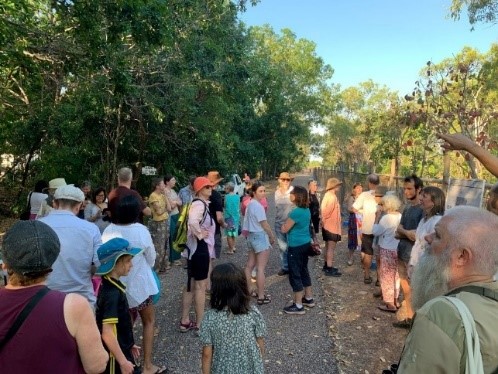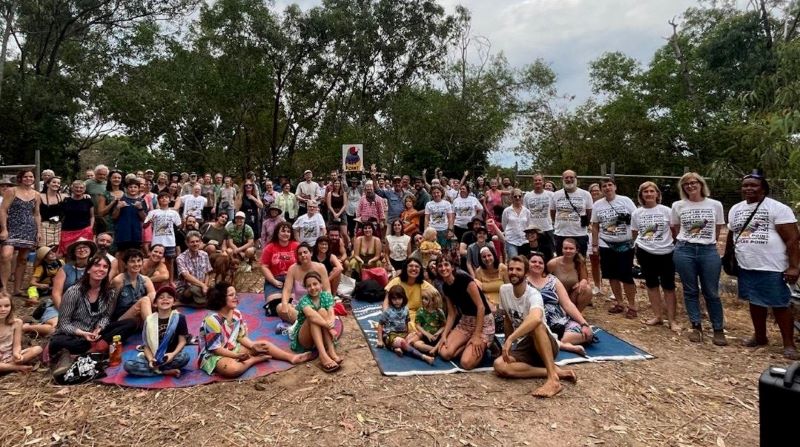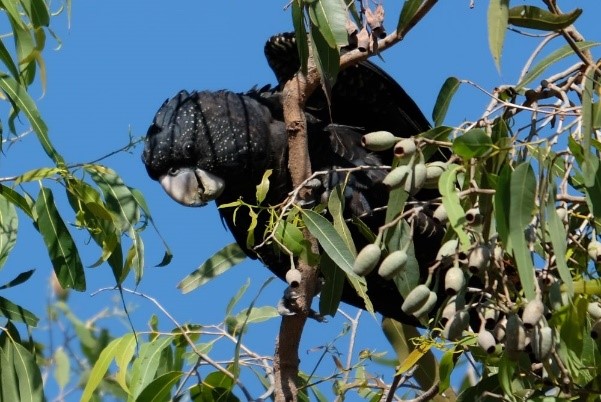
Greetings Friends,
A special thanks to; PLan – Planning Action Network, Environment Centre of the NT (ECNT), Larrakia, Birdlife Top End, NT Field Naturalists and the many people who worked to save Lee Point/Binybara in 2023.
Images of 2023 are presented in these sections;
1.0 INTRODUCTION
2.0 EVENTS
- Gouldian Walks and art
- Migratory shorebirds
- Market stalls, petitions, Colour My World, signs
- Binybara Camp, public meetings, major fire
3.0 BIODIVERSITY
- Old-growth trees
1.0 Introduction
The issue of land clearing at Lee Point/Binybara dominated 2023. A brief summary is:
Last year the federal Minister for the Environment, Tanya Plibersek MP, paused the Lee Point development announcing that Lee Point had Gouldian Finch habitat. In June 2023, she added a 50m buffer around the Lee Point dam for the Gouldian Finch allowing work to proceed.
In July 2023, a bulldozer cleared some habitat in Stage 2 but work was again paused. Cultural heritage matters are now being investigated. Works could start again on 31 March 2024.

Lee Point/Binybara peninsula
2.0 Events
Prior to 2020, less than 15% of Darwin northern suburb residents were aware that government had approved an Area Plan to house thousands of people at Lee Point. Many of the events in 2023 were run to raise community awareness.
Gouldian Walks and Art
There were many self-guided walks around Lee Point Dam during the dry season. While only a handful of Gouldian Finches were seen plenty of other bird species were present. The majority of the walks recorded over 30 species.

Gouldian Finch by Simone Martin in Aug 2023.

Start of a Gouldian Walk

Art workshops were held with some of the Gouldian Walks.
Migratory shorebirds
The Darwin-Garramilla Shorebird Festival on 15 – 17 September organised by Dr Amanda Lilleyman was a great success attracting people from interstate and overseas – refer Sept 23 newsletter. Some of the festival events were held at Lee Point.

Part of the Shorebird Festival Art Exhibition – painting by David Percival
Market stalls, petitions, Colour My World, signs

FLP had a regular stall at the Sunday Nightcliff market and attended some of the Friday Palmerston markets.
Petitions
Over 500 signatures were collected from scientists from two major ecological conferences in Darwin, refer July 23 and Sept 23 newsletter. Scientists also wrote an article in; The Conversation.

Colour My World
A painting/parade event at the Nightcliff Seabreeze festival called “Colour My World” was a great success, refer May 23 newsletter.

Signs

Sign outside Luke Gosling’s office in July
Binybara Camp, art, public meetings, arrests and major fire
The Binybara Camp (Lee Point) provided an important focus for the Save Lee Point campaign and was continuously occupied from late June to 6 August (35 days). It gave people a chance to talk about Lee Point/Binybara, enjoy free music, film and yoga. A vigil was held every Sunday at 5pm that included an art workshop.

Binybara Camp in July 2023

People from Larrakia speaking out against the Lee Point development

Crowd at a Sunday Binybara Vigil

Busy creating art at Binybara

Public meeting at Lyons – Bilingga Park – refer July 23 newsletter
Arrests
Bulldozing happened and (14) people were arrested in July 2023. Channel Nine TV and the ABC along with many other media outlets ran stories on this event.

Stage 2 area before it was bulldozed.

Stage 2 area after bulldozing on 6 July 2023.

Bill (93 years old) with Mililma May (Larrakia) in July. This was Bill’s first protest.
Major fire

A major fire happened 12-14 Aug 2023 – firefighters arriving at Binybara Camp
3.0 Biodiversity
Biodiversity (includes us) is the variety of living things. It is under threat from climate change and habitat loss. Old-growth forests are particularly important for retaining biodiversity.
As old-growth trees disappear in the Darwin-Palmerston area so will tree hollows. Without tree hollows certain Top End native species will not breed ….read more

Red-tailed Black Cockatoos only breed in large hollows found in old-growth trees.

Map of Darwin-Palmerston study area (yellow) and Darwin Wildlife Corridor (green)
In 2022-23, FLP undertook a preliminary study in the Darwin-Palmerston area (212 sq km) to predict what old-growth trees would be left in the future, refer to Dec 23 newsletter. Some findings were:
In 2020, Lee Point had over 700 old-growth trees. Clearing of DHA Stage 1 (in 2021) and partial clearing of Stage 2 (in 2023) has resulted in a 10-15% loss of old-growth trees at Lee Point and a 5-10% loss at the Darwin Wildlife Corridor.
The DHA housing project (if it continues) will clear the majority of old-growth trees from Lee Point peninsula and a significant number from the Darwin Wildlife Corridor.

Lee Point is considered by Charles Darwin University to be vital habitat for small mammals such as the endangered Black-footed Tree-rat and threatened Northern Brushtail Possum.

Black-footed Tree-rat. Northern Brushtail Possum at Lee Point
Lee Point Biodiversity Corridor

Striated Pardalotes spend most of their lives in woodland trees.
This image and many more can be found at; Images from Lee Point Biodiversity Corridor